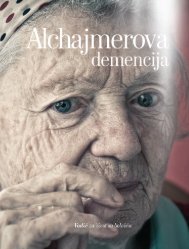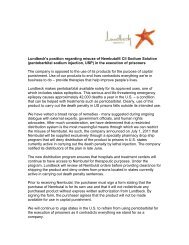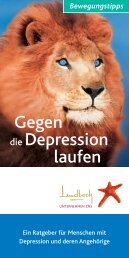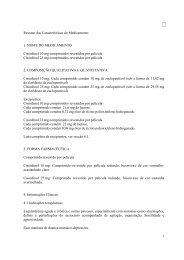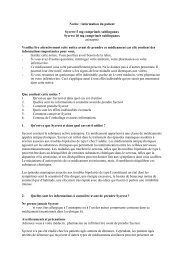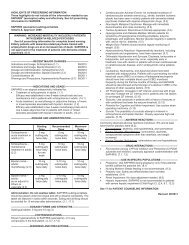Smertekartlegging hos personer med nedsatt kognitiv ... - Lundbeck
Smertekartlegging hos personer med nedsatt kognitiv ... - Lundbeck
Smertekartlegging hos personer med nedsatt kognitiv ... - Lundbeck
- No tags were found...
Create successful ePaper yourself
Turn your PDF publications into a flip-book with our unique Google optimized e-Paper software.
kalisering og kroppsbevegelser. I tillegg kartleggessmerteintensitet under de ulike bevegelsene og lokalisasjon.Systematisk kartlegging av smerte ved hjelp av observasjonsbasertesmertekartleggingsverktøy er et nyttighjelpemiddel for å identifisere smerte <strong>hos</strong> pasienteruten språk. I tillegg må smerte kartlegges både i hvileog under mobilisering. Det er også viktig at helsepersonellbruker sin kliniske erfaring og kjenner pasientengodt fordi ulik adferd kan ha ulik betydning <strong>hos</strong>den enkelte pasienten. <strong>Smertekartlegging</strong>sverktøy ertestet ut ved å måle smerteadferd på gruppenivå, menpasienter uten språk er ikke en homogen gruppe ogpasientene kan ha ulik måte å uttrykke smerte på(”smertesignatur”). Hvis en er i tvil kan en eventueltprøve<strong>med</strong>isinere pasienten <strong>med</strong> smertelindrende <strong>med</strong>ikamenter.nKONKLUSJONSmerte er en personlig og sammensatt opplevelseog kan kun måles ved selvrapportering. Selvrapportering<strong>med</strong> NRS er førstevalg, deretter selvrapportering<strong>med</strong> VRS. Observasjonsbasert kartleggingsskjemaskal bare brukes til <strong>personer</strong> somikke kan selvrapportere smerte. Observasjonsbasertkartlegging må imidlertid alltid suppleres <strong>med</strong>klinisk evaluering.Referanser1. Engedal K, Haugen PK. Demens fakta og utfordringer. En lærebok. Tønsberg, Forlaget Aldring og helse, 2009. 2. Nygaard HA, Naik M, et al. Mental impairmentin nursing home residents. Tidsskr Nor Lægeforen 2000;120:3113-3116. 3. Selbaek G, Kirkevold Ø, Engedal K. The prevalence of psychiatric symptomsand behavioural disturbances and the use of psychotropic drugs in Norwegian nursing homes. Int J Geriatr Psychiatry 2007;Sep;22(9):843-849. 4. TorvikK, Kaasa S, Kirkevold Ø, Rustøen T. Pain in patient living in Norwegian nursing homes. Palliative Medicine 2008;23(1):8-16. 5. Proctor WR, Hirdes JP. Painand cognitive status among nursing home residents in Canada. Pain Res Manag 2001;6(3):119-125. 6. Rustøen T, Wahl AK, Hanestad BR, Lerdal A, Paul S,Miaskowski C. Prevalence and characteristics of chronic pain in the general Norwegian population. Eur J Pain 2004 Dec;8(6):555-565. 7. Nygaard H, JarlandM. Are nursing home patients with dementia diagnosis at increased risk for inadequate pain treatment? Int J Geriatr Psychiatry 2005 Aug;20(8):730-737.8. Miaskowski C. The impact of age on a patient's perception of pain and ways it can be managed. Pain Management Nursing 2000;1(3):2-7. 9. Rustøen T,Wahl AK, Hanestad BR, Lerdal A, Paul S, Miaskowski C. Age and the experience of chronic pain: differences in health and quality of life among younger,middle-aged and older audults. Clin J Pain 2005;21(6):513-523. 10. IASP 2008. IASP definition of pain. Retrieved 28.10.2008. 11. Hofseth C, Norvoll R. Kommunehelsetjenesten- gamle og nye utfordringer. En studie av sykepleietjenesten i sykehjem og hjemmesykepleien. UNIMED Helsetjenesteforskning. Trondheim,SINTEF, 2003. 12. Catananti C, Liperoti R, Settanni S, Lattanzio F, Bernabei R, Fialova D, Landi F. Heart failure and adverse drug reactions among<strong>hos</strong>pitalized older adults. Clin Pharmacol Ther 2009 Sep;86(3):307-310. 13. Gagliese L, Farrell M. The neurolobiology of aging, nociception and pain: an integrationof animal and human experiemental evidence. In pain in older persons. Progress in pain research and management (Gibson SJ & Weiner D eds.).IASP Press, Seattle, 2005. 14. Gibson S, Farrell M. A review of age differences in the neurophysiology of nociception and perceptual experience of pain. ClinJ Pain 2004;20(4):227-239. 15. Scherder EJ, Sergeant JA, Swaab DF. Pain processing in dementia and its relation to neuropathology. Lancet Neurology2003;2:677-686. 16. Herr K, Coyne PJ, McCaffery M, Manworren R. Pain assessment in the patient unable to self-report: position statement with clinicalpractice recommendations. Pain Management Nursing 2011;12(4):230-250. 17. Hadjistavropoulos T, Herr K, Turk DC, Fine PG, Dworkin RH, Helme R, JacksonK, Parmelee PA, Rudy TE, Beattie BL, Chinball JT, Craig KD, Ferrell B, Fillingim RB, Gaglies L, Gallagher R, Gibson SJ, Harrison EL, Katz B, Keefe FJ, Lieber SJ,Lussier D, Schmader KE, Tait RC, Weiner DK, Williams J. An interdisciplinary expert consensus statement on assessment of pain in older persons. Clin J Pain2007;23(1 Supp)1-43. 18. Closs S, Barr B, Briggs M, Cash K, Seers K. A comparison of five assessment scales for nursing home residents with vary degreesof cognitive impairment. J Pain Symptom Manag 2004;27:196-205. 19. Nygaard HA, Jarland M. The checklist of nonverbal pain indicators (CNPI): testingof reliability and validity in Norwegian nursing homes. Age and Ageing 2006;35(1):79-81. 20. Feldt KS, Ryden MB, Miles S. Treatment of pain in cognitivelyimpaired compared with cognitivelyintact older patients with hip-fracture. J Am Geriatr Soc 1998;46:1079-1085. 21. Hølen JC, Saltvedt I, Fayers PM,Bjørnnes M, Stenseth G, Hval B, Filbet M, Loge JH, Kaasa S. The Norwegian Doloplus-2, a tool for behavioural pain assessment: translation and pilot-validationin nursing home patients with cognitive impairment. Palliative Medicine 2005;19:411-417. 22. Hølen JC, Saltvedt I, Fayers PM, Hjermstad MJ, LogeJH, Kaasa S. Doloplus-2, a valid tool for behavioural pain assessment? BMC Geriatrics 2007;19(9):27. 23. Torvik K, Kaasa S, Kirkevold S, Saltvedt S, HølenJC, Fayers P, Rustøen T. Validation of Doloplus-2 among nonverbal nursing home patients - an evaluation of Doloplus-2 in a clinical setting. BMC Geriatrics2010;10:9. 24. Lefebvre-Chapiro S. The Doloplus-2 scale - evaluating pain in the elderly. Eur J Palliat Care 2001;8:191-194. 25. Husebo BS, Strand LI, Moe-Nilssen R, Husebo SB, Snow AL, Ljunggren AE. Mobilization-Observation-Behavior-Intensity-Dementia pain scale (MOBID): Development and validation of anurse-administered pain assessment tool for use in dementia. J Pain Sympt Manag 2007;34(1):67-80. 26. Husebo BS, Strand LI, Moe-Nilssen R, Husebo SB,Ljunggren AE. Pain in older persons with severe dementia. Psychometric properties of the Mobilization-Observation-Behaviour-Intensity-Dementia (MOBID-2) Pain Scale in a clinical setting. Scand J Caring Sci 2010;24(2):380-391.4 • B e s t P r a c t i c e S æ r t r y k k 2 0 1 2




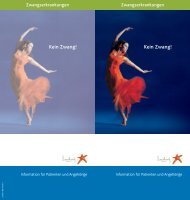
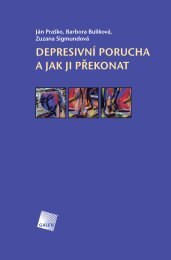

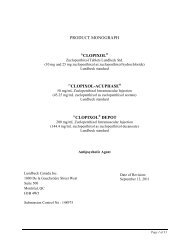
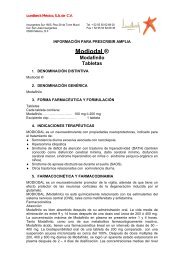

![[Product Monograph Template - Standard] - Lundbeck](https://img.yumpu.com/49015733/1/190x245/product-monograph-template-standard-lundbeck.jpg?quality=85)
